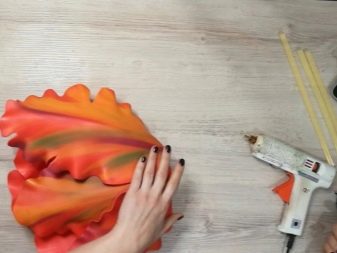How to make tulips from Isolon?

Making crafts from izolon can become an interesting hobby, where everyone shows their imagination and embodies ideas. In addition, the products will decorate the house and can be presented as a gift. It should be noted that this material is best suited for such tasks. Why not spend your free time trying to create something with your own hands. The process is interesting, besides, you can come up with and implement any idea.
Peculiarities
Polyethylene foam, which is izolon, is produced in rolls. This material is often used in the construction industry, but many people also take it for crafts. The thickness of the sheets varies from 0.2 mm to 10 mm. The big advantage is that izolon is presented in a wide range of colors, is easy to dye, and you can create products of different shapes and sizes from it. The material can be processed, cut with ordinary scissors, so there is no better option for making crafts.

To give the isolone a certain shape, it is enough to heat it with an ordinary hair dryer.
The material will cool down and remain as you intended. Thanks to this, you can create any voluminous flowers, compositions, bouquets and decor. Izolon stretches well due to its elasticity, while it does not lend itself to tearing. It is with the help of this technique that original waves are made.

As for the connection of parts, for example, the petals of a future flower from an isolon, you can use an adhesive composition, threads with a needle and even a stapler that can be found in any home. With proper assembly, you can create a beautiful composition of tulips, they can decorate any room and even present a bouquet to a loved one. Growing flowers are easy to do, just choose a variety of plants, cut out a pattern and fasten all the elements in a certain order.


Izolon can be colored, giving the tulip a natural look. If you run a toothpick over the heated material, traces will remain on it, this is necessary to create veins near the leaves and flower petals.
Izolon is not afraid of moisture, however, white sheets must be stored away from direct sunlight, otherwise yellowness will appear on them.
The colored material is UV resistant.


Tools and materials
If you decide to start making growth tulips and want to create a whole composition that will stand in a vase, first you need to prepare improvised materials with tools. Most of the components can be found in every home, you just have to buy something.
- The first step is to purchase isolon in the amount required to make a certain amount of flowers... The material should be pink, yellow or red, depending on the type of tulip you prefer, and you will also need a green isolon for the leaves.

- For heating and shaping, you need either an iron or a hairdryer. It is an indispensable tool that you will use regularly when it comes to creating flowers.


- Purchase several molds, which will serve for a long time and expand the possibilities of needlework.

- Since the materials will have to be painted, it is better to choose acrylic paints that fit well on isolon and are not absorbed. Often, masters use oil or dry pastels, thanks to which you can achieve gentle transitions from one shade to another.



- Prepare regular scissors, green tape for processing stems and twigs, glue or glue gun. Small parts can be attached "Momentarily".



Of course, you can't do without floristic wire.... Once all of the above is collected, you can prepare the workplace, free up space at the table, lay out the materials with tools and start creating a beautiful bouquet of delicate tulips.

Execution technique
Your attention is invited to a master class with a step-by-step guide, thanks to which even a beginner can cope with the work. After that, you can create crafts on your own, using all your imagination, because there is only one technique for working with isolon.
- To make spring tulips, you need prepare drawings for future petals. Why not put a real flower in front of you to study its structure and try to convey the naturalness of this plant as much as possible. Only in this way the craft will be similar to its prototype, because you can take into account the shape, proportion and convey the desired shades.

- To do templates, use strong cardboard, on which you need to draw sepals, petals and tulip leaves, stamen.

- Then cut out and attach to the sheets of isolon, circling with a toothpick... Now you have the elements of the flower that you want to give them a natural shape.

- Aim the hair dryer at the petals and leaves to curl the edges a little.... Apply the appropriate type of mold to leave streaks in the material.

- The next step is to glue all the pieces together. The tulip has four petals, which must be connected in pairs. They must be formed around the rod, the task of which is performed by the floral wire.

- Previously, the petals can be tinted with pastel., using a damp cloth, with which it is necessary to blot the crayons, and then, using patting movements, apply to the isolon part.

- The top of the stem is placed in the center of the flower cup and fixed with a glue gun.

- If you want to make a growth tulip, then you need to take a plastic pipe so that it can support the tulip head. Petals are glued around the stamen, and you can start winding the wire or pipe with tape.

- The tulip leaves are attached in the same way as the rest of the details. You can bend the stem slightly to make the flower look more natural, and your craft will be ready.

Flowers can be small or large, isolon can be used to create a growth tulip in the form of a lamp to decorate the interior. Products made from such material look very natural if you follow the instructions and recommendations of the masters regarding the processing of polyethylene foam. The result of the work will bring great joy, but the process itself will be interesting and entertaining. You can make a bouquet of tulips of different colors and shades to put in a vase, this will liven up the interior.
Watch the video for a master class on making a tulip from an isolone.








